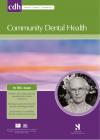Community Dental Health

- Cover Date:
- December 2011
- Print ISSN:
- 0265 539X
- Vol:
- 28
- Issue:
- 4
The effect of a modified fluoride toothpaste technique on buccal enamel caries in adults with high caries prevalence: a 2-year clinical trial
Objective: To evaluate the preventive effect of a “modified fluoride (F) toothpaste technique†on the incidence and progression of buccal/ lingual enamel caries among Saudi adults with high caries prevalence. Method: Adults were randomly assigned to test and control groups. Test group patients were instructed to use the provided F toothpaste twice a day as follows: 1, use 2cm toothpaste; 2, brush for 2min; 3, swish the toothpaste slurry around the teeth for about half a minute before spitting it out; and 4, no post-brushing water rinsing and no eating/drinking for 2hr. The patients in the control group (n=57) were instructed to continue using their regular F toothpaste twice a day without any further instructions. The patients’ compliance in the test group was assessed after 2 years. Results: Of 175 adults, 113 completed the study. The test group (n=56) had a lower enamel mean caries incidence 0.56 (sd 1.04) than the control group (n=57), 1.01 (1.00) (p<0.05), with a preventive fraction of 44%. There was no difference regarding enamel caries progression or arrested caries. The caries incidence in the test group was higher in the subgroup of patients who rinsed with water post-brushing and who only brushed once a day (p<0.05). Conclusion: The “modified fluoride toothpaste techniqueâ€, as practised over the 2 years in a Saudi population with high caries prevalence, had a preventive effect on the incidence of buccal/lingual enamel caries but not on the progression.
Key words: adults, dental restorations, enamel caries, fluoride toothpaste, Saudi Arabia.
- Article Price
- £15.00
- Institution Article Price
- £
- Page Start
- 292
- Page End
- 296
- Authors
- H. Sonbul, K. Merdad, D. Birkhed
Articles from this issue
- Title
- Pg. Start
- Pg. End
- Why has oral health promotion and prevention failed children requiring general anaesthesia for dental extractions?
- 255
- 258
- Predictors of utilisation of dental care services in a nationally representative sample of adults
- 269
- 273
- Applicability of both dentist and patient perceptions of dentists’ explanations to the evaluation of dentist–patient communication
- 274
- 279
- Evaluation of a preventive program based on caries risk among mentally challenged children using the Cariogram model
- 286
- 291
- The effect of a modified fluoride toothpaste technique on buccal enamel caries in adults with high caries prevalence: a 2-year clinical trial
- 292
- 296
- Association of clinical oral health status with self-rated oral health and GOHAI in Japanese adults
- 297
- 300
- Prevalence of periodontopathogens in a black Brazilian secluded community matched with a black urban population
- 301
- 304
- Incisor trauma in a Turkish preschool population: Prevalence and socio-economic risk factors
- 308
- 312
- Malocclusion and orthodontic treatment need measured by the Dental Aesthetic Index and its association with dental caries in Indian schoolchildren
- 313
- 316
